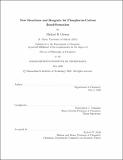| dc.contributor.advisor | Christopher C. Cummins. | en_US |
| dc.contributor.author | Geeson, Michael B. | en_US |
| dc.contributor.other | Massachusetts Institute of Technology. Department of Chemistry. | en_US |
| dc.date.accessioned | 2020-09-15T21:57:08Z | |
| dc.date.available | 2020-09-15T21:57:08Z | |
| dc.date.copyright | 2020 | en_US |
| dc.date.issued | 2020 | en_US |
| dc.identifier.uri | https://hdl.handle.net/1721.1/127425 | |
| dc.description | Thesis: Ph. D., Massachusetts Institute of Technology, Department of Chemistry, May, 2020 | en_US |
| dc.description | Cataloged from the official PDF of thesis. Page 373 blank. | en_US |
| dc.description | Includes bibliographical references. | en_US |
| dc.description.abstract | Chapter 1 takes the format of an "Outlook", and sets forth the case for developing sustainable methods in the synthesis of phosphorus-containing compounds. Methods used by nature for phosphorus-carbon bond-formation, or in the chemistry of other elements such as silicon, are discussed as model processes for the future of phosphorus in chemical synthesis. Chapter 2 describes the discovery of [TBA][P(SiCl₃)₂], prepared from [TBA]₃[P₃O₉]-.2H₂O and trichlorosilane. The bis(trichlorosilyl)phosphide anion is used to prepare compounds that contain P-C, P-O, P-F, and P-H bonds in a method that bypasses white phosphorus (P₄), the traditional route to organophosphorus compounds. Chapter 3 extends the phosphate precursors to [TBA][P(SiCl₃)₂] from trimetaphosphate to crystalline phosphoric acid. | en_US |
| dc.description.abstract | Balanced equations are developed for the formation of [TBA][P(SiCl₃)₂] from phosphate sources and the byproducts are identified as hexachlorodisiloxane and hydrogen gas. Extension of trichlorosilane reduction to bisulfate provides improved access the known trichlorosilylsulfide anion, [TBA][SSiCl₃]. This anion was used as a thionation reagent to prepare thiobenzophenone and benzyl mercaptan from benzophenone and benzyl bromide, respectively. Chapter 4 describes the synthesis of neutral phosphine, HP(SiCl₃)₂, obtained by protonation of [TBA]1 with triflic acid. HP(SiCl₃)₂ is a highly efficient reagent for photochemical hydrophosphination of terminal alkenes. The phosphorus-silicon bonds in the hydrophosphination products can be functionalized to provide compounds of the general formulae: RPCl₂, RPH₂, [RP(R')₃]Cl, RP(O)(H)(OH), and RP(O)(OH)₂. | en_US |
| dc.description.abstract | Chapter 5 describes a method to prepare phosphiranes (three-membered rings that contain a phosphorus atom) from anthracene-based phosphinidene precursors and styrenic olefins. The phosphinidene transfer reaction requires an organoiron and fluoride catalyst. The resulting phosphirane is prepared in good yield (73%) with high stereoselectivity (>99%). Experimental investigations into the mechanism point toward the intermediacy of an iron-coordinated fluorophosphide species. | en_US |
| dc.description.statementofresponsibility | by Michael B. Geeson. | en_US |
| dc.format.extent | 373 pages | en_US |
| dc.language.iso | eng | en_US |
| dc.publisher | Massachusetts Institute of Technology | en_US |
| dc.rights | MIT theses may be protected by copyright. Please reuse MIT thesis content according to the MIT Libraries Permissions Policy, which is available through the URL provided. | en_US |
| dc.rights.uri | http://dspace.mit.edu/handle/1721.1/7582 | en_US |
| dc.subject | Chemistry. | en_US |
| dc.title | New reactions and reagents for phosphorus-carbon bond-formation | en_US |
| dc.type | Thesis | en_US |
| dc.description.degree | Ph. D. | en_US |
| dc.contributor.department | Massachusetts Institute of Technology. Department of Chemistry | en_US |
| dc.identifier.oclc | 1192965220 | en_US |
| dc.description.collection | Ph.D. Massachusetts Institute of Technology, Department of Chemistry | en_US |
| dspace.imported | 2020-09-15T21:57:08Z | en_US |
| mit.thesis.degree | Doctoral | en_US |
| mit.thesis.department | Chem | en_US |
